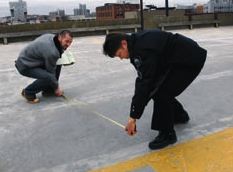 This summer, vegetables, flowers and herbs will take the place of some of the cars and trucks atop a MIT garage becoming the Institute’s first-ever community garden.
This summer, vegetables, flowers and herbs will take the place of some of the cars and trucks atop a MIT garage becoming the Institute’s first-ever community garden.
Not only is it a way to reduce their carbon footprint. The project also aims to foster community and give back to those in need: At least 2 percent of all harvested produce will be given to Food for Free, a local charity that finds and distributes fresh food to pantries, meal programs and shelters.
The pilot program in urban sustainable agriculture is the result of a months-long effort spearheaded by MIT Police Sgt. Cheryl Vossmer and Libraries Administrative Assistant and Public Service Support Associate Ryan Gray. Working with administrators and staff across the Institute, the two were able to secure seven little used parking spaces and a strip of grass at West Garage to house the garden, which will comprise several dozen plots. The remainder of the spots on the garage’s roof will still be open for parking this summer.
Each plot will consist of one EarthBox, a low-cost, compact and water-efficient growing container that’s about the size of a large suitcase. The EarthBoxes will be available for purchase, at a discount and complete with soil and fertilizer, through MIT’s Endicott House. While there is no fee for a plot, gardeners must supply the EarthBox, soil and plants.
There will be approximately four plots per parking space, and several more on the grass next to the garage. In the program’s first year, plots will only be made available to faculty and staff — but Gray notes that opening up the program to students is an “absolute possibility” in subsequent years, especially graduate students, who are around campus during the summer months.
The growing season will last from Memorial Day, May 25, through Labor Day, Sept. 7, at which point all the boxes will have to be removed from the garage by their plotholders to get ready for the Fall rush of students.
Gray calls the community garden perfect for “building community when it is most necessary. Anything that gets people to think about something other than [the economy] is a good thing.”
(Original article in MIT Tech Talk, April 8)



















